| Oracle9i Net Services Administrator's Guide Release 2 (9.2) Part Number A96580-02 |
|
|
View PDF |
| Oracle9i Net Services Administrator's Guide Release 2 (9.2) Part Number A96580-02 |
|
|
View PDF |
This chapter introduces the various administration tools of Oracle Net Services. It discusses the main administration application, Oracle Net Manager, and describes how to launch and navigate through it. It also introduces the command line control utilities.
This chapter contains these topics:
Oracle Net Manager is a graphical user interface tool that combines configuration abilities with Oracle Names component control to provide an integrated environment for configuring and managing Oracle Net. It can be used on either the client or server. Oracle Net Manager is also integrated with Oracle Enterprise Manager.
You can use Oracle Net Manager to configure the following network components:
tnsnames.ora files, a centralized LDAP-compliant directory service, or an Oracle Names server.If an Oracle Names server is configured, you can start, stop, tune, or gather statistics for it with Oracle Net Manager.
This section introduces you to the features of Oracle Net Manager. However, the primary documentation for using Oracle Net Manager is the accompanying online help. This section contains these topics:
You can start Oracle Net Manager using the Oracle Enterprise Manager Console or as an independent application.
To start Oracle Net Manager from the Oracle Enterprise Manager console, on the Oracle Enterprise Manager console, choose Tools > Service Management > Oracle Net Manager.
To start Oracle Net Manager as standalone application:
netmgr from $ORACLE_HOME/binThe Oracle Net Manager interface includes two panes, a toolbar, and various menu items.
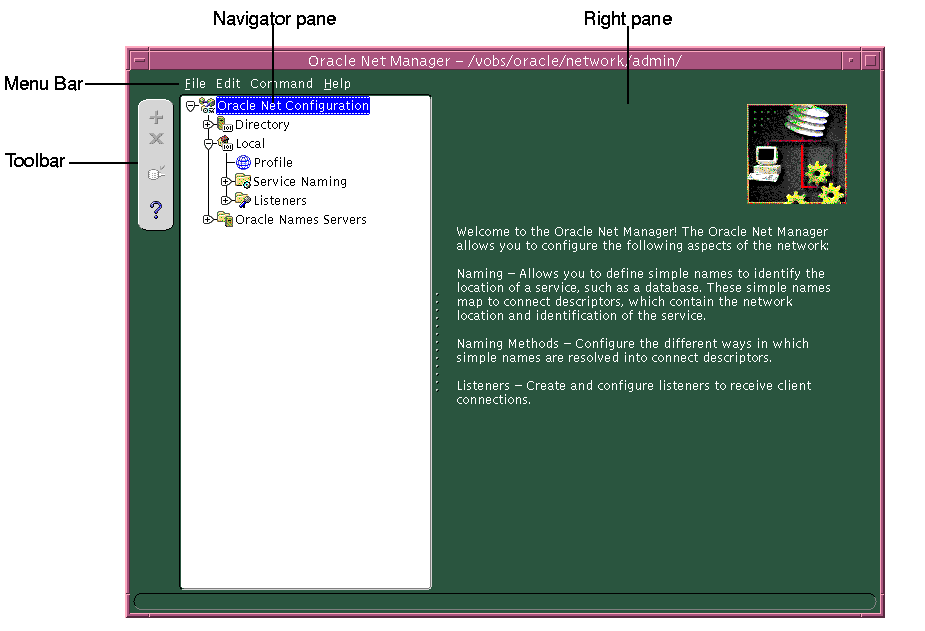
The Oracle Net Manager interface has two panes: the navigator pane and the right pane.
The navigator pane provides a graphical tree view of network objects and the objects they contain, organized in hierarchies of folders. You can use the navigator pane to view, modify, add, or delete objects in each folder.
The navigator pane functions the same way as it does in other Oracle Enterprise Manager applications. That is, the navigator pane lets you:
When you expand a folder, you see a nested list of objects and folders. When a object is selected, information about the object is displayed in the right pane of the Oracle Net Manager.
Table 5-1 lists the main folders in the navigator pane.
The right pane contains property sheets that enable you to configure network components. Figure 5-2 shows the Service Attributes property sheet used for connect identifier configuration.
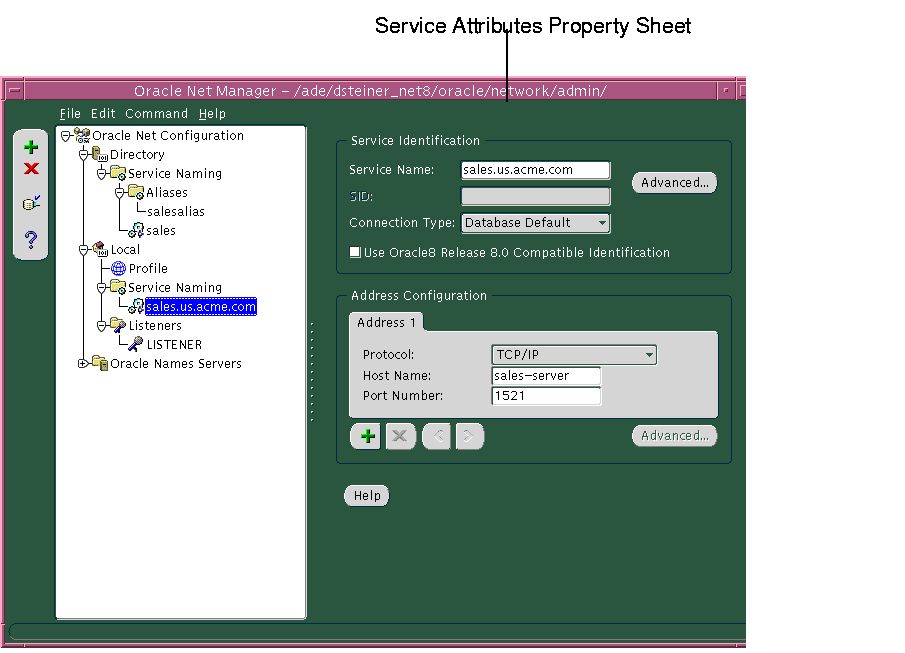
The toolbar contains buttons that correspond to the network objects in the folder hierarchies. The toolbar buttons are enabled depending on the objects viewed or selected in a pane. Move the mouse cursor over a toolbar button to display the description of the button's function. The toolbar buttons are:
This button creates new connect identifiers, listeners, and Oracle Names servers objects under the Directory or Local > Service Naming, Listeners, and Oracle Names Servers folders.
This button deletes connect identifier and listener objects under the Directory or Local > Service Naming and Listeners folders.
This button verifies the connectivity of a selected connect identifier to an Oracle database service. During a connectivity test, a connection to a database service is made by using connect descriptor information stored in a directory server or a tnsnames.ora file.
The Help button opens the Oracle Net Manager online help.
You use Oracle Net Manager menus to perform actions, such as testing connectivity to an Oracle database, and to open wizards and dialog boxes. The following list describes the items available under each menu.
Table 5-2 describes the contents of the File menu.
Table 5-3 describes the contents of the Edit menu.
Table 5-4 describes the contents of the Command menu.
| Option | Description |
|---|---|
|
Directory |
The Directory submenu contains the following menu items: Change Current Context: Enables you to change the current Oracle Context. The Oracle Context is a subtree in the directory that stores Oracle entries, including database services and net service names for use with directory naming. When a new Oracle Context is selected, objects in the navigator's Oracle Net Configuration > Directory or Local > Service Naming folder display for the new Oracle Context. Set Authentication: Enables you to set authentication credentials to the directory server Import Net Service Names: Launches the Directory Server Migration Wizard. This wizard imports net service names stored in a |
|
Test Service |
Connects to a database service using connect descriptor information stored in a directory server or a |
|
Discover Oracle Names Servers |
Finds Oracle Names servers. Once the client finds an Oracle Names server, it queries for all other Oracle Names servers in the domain. Based on the Oracle Names servers found, a list of Oracle Names servers is created on the client. The list is created in order of response time. See Also: "About Discovery" |
|
Reload All Names Servers |
The Oracle Names server checks immediately for data changes in its administrative region. If there are changes, the Oracle Names server reloads all stored data. |
Table 5-5 describes the contents of the Help menu.
| Option | Description |
|---|---|
|
Contents |
Opens Oracle Net Manager online help |
|
About Oracle Net Manager |
Opens a window that displays the Oracle Net Manager version number and copyright information |
The Oracle Net Manager wizards provide step-by-step guidance for tasks that require many steps. The wizards simplify complex tasks by guiding you through the task in manageable steps. The wizards are not intended to provide all configuration options. Once you have completed a task with a wizard, use other components of Oracle Net Manager to modify the configuration.
The following topics describe the Oracle Net Manager wizards:
The Net Service Name Wizard guides you through creating a basic net service name in a directory server or a tnsnames.ora file.
To start the Net Service Name Wizard to create net service names:
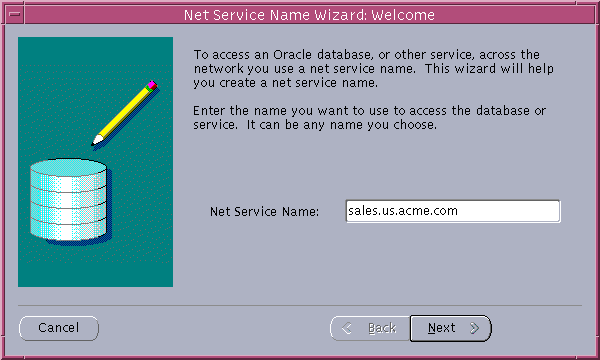
Text description of the illustration netwiz1.gif
If a tnsnames.ora file already exists, its net service names can be exported to a directory server with the Directory Server Migration Wizard.
To start the Directory Server Migration Wizard, choose Command > Directory > Import Net Service Names in the Oracle Net Manager menu bar.
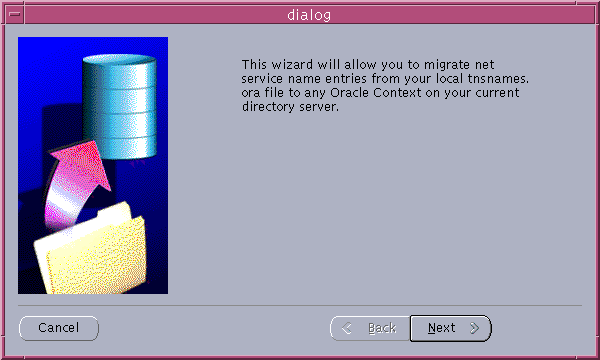
Text description of the illustration migtolda.gif
The Names Wizard guides you through creating and configuring an Oracle Names server.
To start the Net Service Name Wizard to create an Oracle Names server:
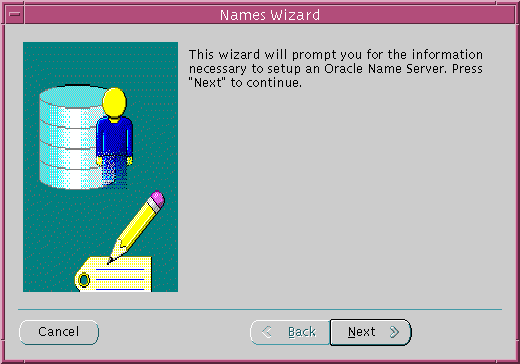
Text description of the illustration nameswiz.gif
| See Also:
"Task 3: Create an Oracle Names Server" for more information about the Names Wizard |
|
Note: In future releases, Oracle Names will not be supported as a centralized naming method. Because no new enhancements are being added to Oracle Names, consider using directory naming or migrating an existing Oracle Names configuration to directory naming, as described in Chapter 10, "Exporting Naming Data to a Directory Server". |
Oracle Net Configuration Assistant is provided primarily to configure basic network components during installation, including:
tnsnames.ora fileOracle Net Configuration Assistant runs automatically during software installation, as described in your Oracle installation guide.
It can also be run after installation in standalone mode to configure naming method usage, the listener, net service names in the tnsnames.ora file, and directory server usage in a similar way that is provided during installation.
To start Oracle Net Configuration Assistant:
netca from $ORACLE_HOME/bin.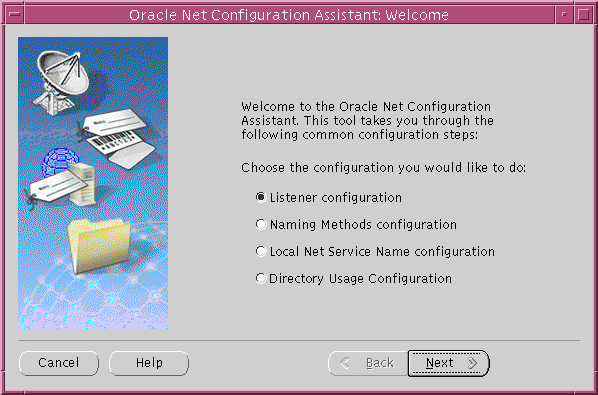
Text description of the illustration netca1.gif
Table 5-6 describes the configuration options in the Welcome page:
Oracle Net provides the following tools to help you start, stop, configure, and control each network component:
The Listener Control utility enables you to administer the listener. The basic syntax for this utility is as follows:
LSNRCTL command [listener_name]
For example, the following command starts a listener named lsnr:
LSNRCTL START lsnr
You can also issue Listener Control utility commands at the LSNRCTL> program prompt. To obtain the prompt, enter lsnrctl with no arguments at the operating system command line. When you run lsnrctl, the program is started. You can then enter the necessary commands from the program prompt.
For example:
lsnrctl LSNRCTL> START lsnr
| See Also:
Oracle9i Net Services Reference Guide for further information about the Listener Control utility |
The Oracle Connection Manager Control utility enables you to administer an Oracle Connection Manager. The basic syntax for this utility follows:
CMCTL command [process_type]
where process_type is the name of the Oracle Connection Manager process. The choices are as follows:
cman for both the CMGW process (gateway process) and the CMADMIN process (administrative process)cm for the CMGW processadm for the CMADMIN processFor example, the following command starts both the CMGW and the CMADMIN processes:
CMCTL START cman
You can also issue Oracle Connection Manager utility commands at the CMCTL> program prompt. To obtain the prompt, enter cmctl with no arguments at the operating system command line. When you run cmctl, the program is opened. You can then enter the necessary commands from the program prompt.
For example:
cmctl CMCTL> START cman
See Also:
|
The Oracle Names Control utility enables you to administer an Oracle Names server. The basic syntax for this utility follows:
NAMESCTL command [arguments]
For example, the following command starts Oracle Names server configured in the local node's names.ora file:
NAMESCTL START
You can also issue Oracle Names Control utility commands at the NAMESCTL> program prompt. To obtain the prompt, enter namesctl with no arguments at the operating system command line. When you run namesctl, the program is started. You can then enter the necessary commands from the program prompt.
For example:
namesctl NAMESCTL> START
| See Also:
Oracle9i Net Services Reference Guide for further information about the Oracle Names Control utility |
Network configuration and administration tasks are described throughout this guide. Table 5-7 lists the common tasks, the tools associated with them, and points you to the topic in the guide that describes the task.
| Task | Tools to Perform Task | See Also |
|---|---|---|
|
Configuring Directory Server for Oracle Net Usage |
||
|
Configure directory server usage. |
Oracle Net Configuration Assistant |
|
|
Add users to the OracleNetAdmins group. |
Oracle Net Configuration Assistant |
|
|
Authenticate with the directory. |
Oracle Net Manager |
Choose Directory > Service Naming > How To > Change the Oracle Context in the online help |
|
Change the Oracle Context. |
Oracle Net Manager |
Choose Directory > Service Naming > How To > Set Authentication Credentials in the online help |
|
Configuring Naming Methods |
||
|
Configure the local naming method. |
Oracle Net Configuration Assistant Oracle Net Manager |
|
|
Configure the directory naming method. |
Oracle Net Configuration Assistant Oracle Net Manager |
|
|
Configure the Oracle Names method. Note: In future releases, Oracle Names will not be supported as a centralized naming method. Instead, consider using directory naming or migrating an existing Oracle Names configuration to directory naming, as described in Chapter 10, "Exporting Naming Data to a Directory Server". |
Oracle Net Manager |
|
|
Configure the host naming method. |
Oracle Net Manager |
|
|
Configure external naming methods. |
Oracle Net Manager |
|
|
Migrating to Directory Naming |
||
|
Export from |
Oracle Net Manager |
|
|
Export from Oracle Names. |
Oracle Names Control Utility |
|
|
Configuring Profiles |
||
|
Prioritize naming methods. |
Oracle Net Configuration Assistant |
|
|
Configure a default domain that is automatically appended to any unqualified net service name. |
Oracle Net Configuration Assistant |
|
|
Route connection requests. |
Oracle Net Configuration Assistant |
|
|
Configure access control. |
Oracle Net Manager |
|
|
Configure an authentication method available with Oracle Advanced Security. |
Oracle Net Manager |
"Configuring Oracle Advanced Security" |
|
Configure connect request timeouts. |
Manual Configuration |
"Configuring the Listener and the Oracle Database To Limit Resource Consumption By Unauthorized Users" |
|
Configuring Listeners |
||
|
Configure listening protocol addresses. |
Oracle Net Configuration Assistant |
|
|
Configure dynamic service registration. |
Automatic |
|
|
Configure static service registration. |
Oracle Net Manager |
|
|
Configure password authentication. |
Oracle Net Manager |
|
|
Configure connect request timeouts. |
Manual Configuration |
"Configuring the Listener and the Oracle Database To Limit Resource Consumption By Unauthorized Users" |
|
Administering Listeners |
||
|
Start and stop listeners. |
Listener Control Utility |
|
|
View registered information. |
Listener Control Utility |
|
|
Configuring Oracle Connection Manager |
||
|
Configure session multiplexing. |
Manual Configuration |
|
|
Configure access control. |
Manual Configuration |
|
|
Configure protocol conversion support. |
Manual Configuration |
|
|
Configuring Oracle Names Servers |
||
|
Configure Oracle Names LDAP proxy servers. |
Oracle Net Manager |
|
|
Create Oracle Names servers. |
Oracle Net Manager |
|
|
Create a list of preferred Oracle Names servers. |
Oracle Net Manager |
|
|
Register objects with Oracle Names servers. |
Oracle Net Manager |
|
|
Delegate domains to delegated administrative regions. |
Oracle Net Manager |
"Task 8: Delegate Domains to Delegated Administrative Regions" |
|
Specify domain hints. |
Manual Configuration |
"Task 9: Specify Domain Hints to Forward Requests to Remote Oracle Names Servers" |
|
Administering Oracle Names Servers |
||
|
Start and stop Oracle Names servers, as well as gather statistics |
||
|
Oracle Net Manager |
Choose Oracle Names Servers > How To > Administer an Oracle Names Server in the online help |
|
|
Remove an Oracle Names server. |
Oracle Net Manager |